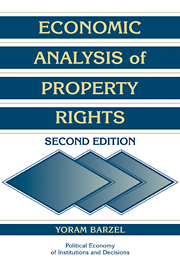Book contents
- Frontmatter
- Contents
- Series editors' preface
- Preface to the second edition
- Preface to the first edition
- Introduction
- 1 The property rights model
- 2 The public domain: Rationing by waiting and price controls
- 3 Contract choice: The tenancy contract
- 4 Divided ownership
- 5 The old firm and the new organization
- 6 The formation of rights
- 7 Slavery
- 8 Wealth-maximizing constraints on property rights
- 9 Property rights and non-market allocation
- 10 Additional property rights applications
- 11 The property rights model: Recapitulation
- References
- Index
8 - Wealth-maximizing constraints on property rights
Published online by Cambridge University Press: 05 June 2012
- Frontmatter
- Contents
- Series editors' preface
- Preface to the second edition
- Preface to the first edition
- Introduction
- 1 The property rights model
- 2 The public domain: Rationing by waiting and price controls
- 3 Contract choice: The tenancy contract
- 4 Divided ownership
- 5 The old firm and the new organization
- 6 The formation of rights
- 7 Slavery
- 8 Wealth-maximizing constraints on property rights
- 9 Property rights and non-market allocation
- 10 Additional property rights applications
- 11 The property rights model: Recapitulation
- References
- Index
Summary
The economists who first adopted the property rights framework in their analyses often considered any government restrictions on those rights (“attenuation of rights”) to be undesirable. A person's ability to realize the potential value of his or her property depends on the extent of his or her property rights, which consists of the ability to use (and exclude), to alienate, and to derive income from the property. The ability, or power, to exclude prevents the property from becoming common property, and the ability to alienate and to derive income permits the realization of gains from exchange. Since restrictions generally reduce freedom of action, restrictions on a person's property rights reduce the value of the property to its owner. Thus it would appear that such restrictions are harmful. In this section I will demonstrate that restrictions that seem to attenuate rights in fact often help to delineate rights more clearly.
Restrictions, that is, non-price allocations, can have no useful role in the Walrasian model. According to that model prices alone can direct all resources into their highest-value uses and will yield efficient allocation, since price adjustments are costless and rights are well defined. Restrictions, then, are at best superfluous and may well result in lower output. The unfavorable attitude by economists toward restrictions on, or attenuation of, rights may reflect the implicit application of the Walrasian, costless-transacting model.
In spite of the Walrasian model, restrictions on individuals' freedom to do what they wish with “their” property are widespread even in capitalist market economies.
- Type
- Chapter
- Information
- Economic Analysis of Property Rights , pp. 114 - 127Publisher: Cambridge University PressPrint publication year: 1997



